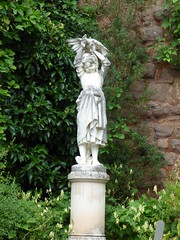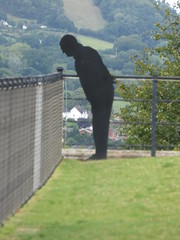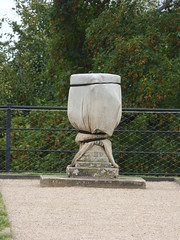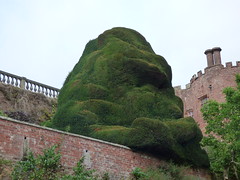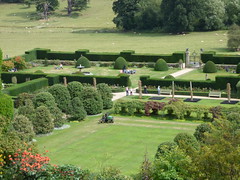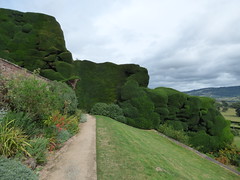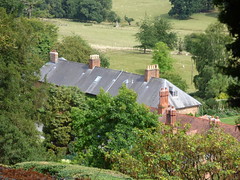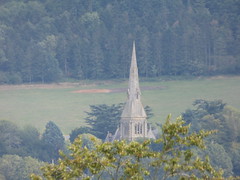
A visit to Powis Castle, another National Trust property. A look around the gardens at Powis Castle.
Powis Castle (Welsh: Castell Powys) is a medieval castle, fortress and grand country mansion near Welshpool, in Powys, Wales.
It is known for housing the treasures that were brought home by Robert Clive and his son, Edward Clive from India. The Clives obtained them during their service with the British East India Company.
The castle has also been known as Castell Coch, Castell Pool, Castell Pola, Castell Pole, Castell Trallwng, Red Castle, Redde Castle and Castel Cough.
The seat of the Earl of Powis, the castle is known for its extensive, attractive formal gardens, terraces, parkland, deerpark and landscaped estate. The property is under the care of the National Trust.
Princess Victoria (later Queen Victoria) visited the castle as a child when her mother took her to tour England and Wales in 1832.
Upper Terrace
Distance views.
view of a church spire.
Leighton Church
Grade II* Listed Building
Church of the Holy Trinity, Leighton
History
Built 1851-53 by the Liverpool architect W.H. Gee. Its patron was John Naylor who had acquired the Leighton Estate in 1846-47 and embarked on an ambitious programme of building, notably the church, Leighton Hall and Leighton Farm, all designed by Gee and completed by the mid 1850s. Naylor lavished money on the church, employing the Liverpool firm of Forrest and Bromley to furnish it with glass, and having Minton tiles laid throughout.
Exterior
In an extravagant Decorated style, consisting of nave with aisles, S porch, NW tower with spire, SE chapel and N vestry. Of coursed, rock-faced Cefn stone with steeply pitched slate roofs (behind coped gables in the nave and chancel). The windows and doorways have hood moulds with head or foliage stops, while the doors all have ornate strap hinges and studding. The 5-bay nave has flying buttresses, ashlar eaves with a plain corbel table, and alternate paired and triple lancets in the clerestorey. The aisle windows are 2-light, each with a different style of Decorated tracery, and have a continuous sill band. The nave has a 5-light W window, the S aisle a circular W window. The S porch has angle buttresses and a coped gable with an empty statue niche below the ridge. The doorway has open tracery beneath the arch. The SE chapel is octagonal with a pyramidal slate roof, stepped buttresses and 2-light S and E windows with continuous sill band. On the W side is a sculpture of a woman holding a book amidst foliage. On W side of the chapel is a detached pier with conical cap, linked to the S aisle by a pointed arch. Between arch and chapel is a doorway under a trefoil window and steep gable to the lobby between aisle and chapel. The chancel has ashlar eaves and machicolations in the N and S walls above a row of 5 cusped lancets; 5-light E window. The N vestry has angle buttresses, 2 paired lancets with sill band on the N side together with stone steps to a crypt, and a doorway on E side which has a tympanum with the date 1853 and a Green Man in relief. The N aisle has windows similar to the S. The 3-stage tower has angle buttresses. The stages are defined by continuous string courses, beneath the lower of which is a frieze of blank arches which have foliage in the spandrels. The lower stage of the tower houses a second porch, now the main entrance. It has an elaborate N doorway consisting of 2 orders of attached shafts and a moulded arch (incorporating a vine trail with a Green Man at the ridge) beneath a gablet. The gablet has a finial and beneath it is a cross with foliage. The hood mould of the doorway also has stops in the form of winged angels bearing scrolls (reading 'Fear God' and 'Honour the king'). Three-light W window with trefoil-headed light and a hood mould continuous with a string course. In the middle stage is a small narrow window in each face. The upper stage has triple stepped lancets with louvres, above which are machicolations. The tall broach spire has crockets and 3 tiers of lucarnes.
Interior
The interior has lofty proportions with a tall chancel arch and is as richly treated as the exterior. The 5-bay N and S arcades have piers with attached shafts with fillets, moulded capitals and arches. The clerestorey windows have sill bands. The nave has a hammer-beam roof on wall shafts which end above the arcade piers and have foliage capitals and head corbels. Brackets support the hammer beams and have carved angels on the undersides. There is open tracery above and below the hammer beams. The roof has boarded panels. The aisle roofs have arched braces with tracery above. The chancel has a keeled wagon roof with ribs embossed with foliage and boarded panels. The chancel is faced in ashlar with 5-bay blind arcades under crocketed gables in the N and S walls. The N and S windows have a sill band with billets and head stops and above them is a cornice incorporating vine trails and billets with head stops. In the E wall is a 5-bay reredos which has crocketed gables with tracery below, foliage capitals and shafts with fillets. In the blank panels are engraved texts from the Old and New Testaments, including the Lord's Prayer.
The original stained glass by Forrest and Bromley of Liverpool survives in its entirety. In the W window are mainly Old Testament scenes with emblems of the 12 Tribes of Israel in the tracery lights. In the E window are Christ and the 4 Evangelists represented in niches. In the aisle windows the monogram of John Naylor is prominent. The floor consists entirely of Minton tiles, in richer patterns in the chancel.
The Naylor chapel is reached from a small lobby E of the S aisle and with an external S door. Inside the chapel is a sculpture of an angel seated on a rock by Georgina Naylor. On the walls are tablets to members of the Naylor family.
Pews span the nave so that there is no central aisle. They are also arranged hierarchically: the front 3 pews have arm rests and ends with poppy heads; the pews behind have square-headed ends with blind tracery; each aisle has a continuous bench against the wall. At the E end of the S aisle is a family pew. The richly-decorated pulpit is hexagonal and on a pedestal. The communion rails have open-tracery panels. The font is hexagonal in polished stone with a New Testament inscription around the rim.
Reasons for Listing
Listed Grade II* as one of the best examples of a Victorian Estate church in Wales. It is especially notable for the sumptuousness of its architectural language, and for the completeness and high quality of its interior fittings. The church is also one of the showpiece buildings of the Leighton Estate, an exceptional example of high-Victorian estate development. The estate is remarkable for the scale and ambition of its conception and planning, the consistency of its design, the extent of its survival, and is the most complete example of its type in Wales. The church is a key element in this whole ensemble.





